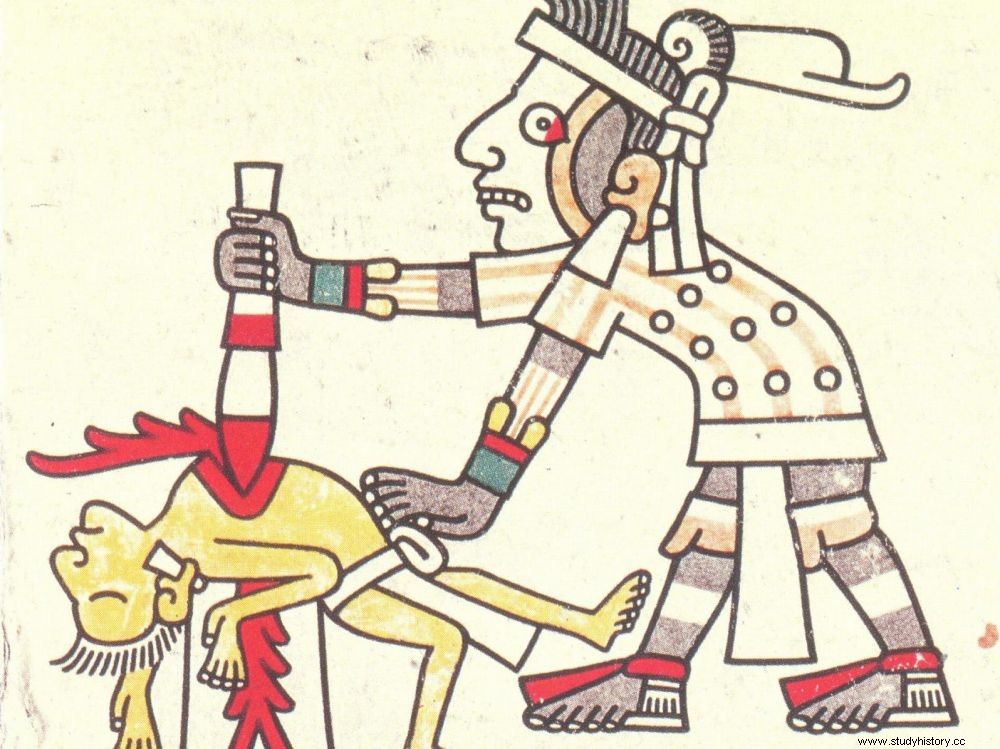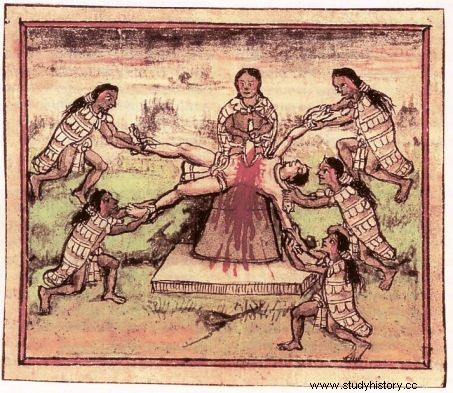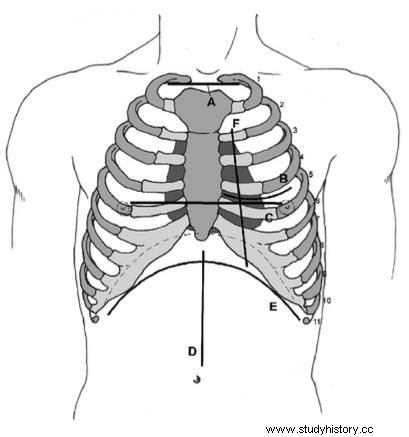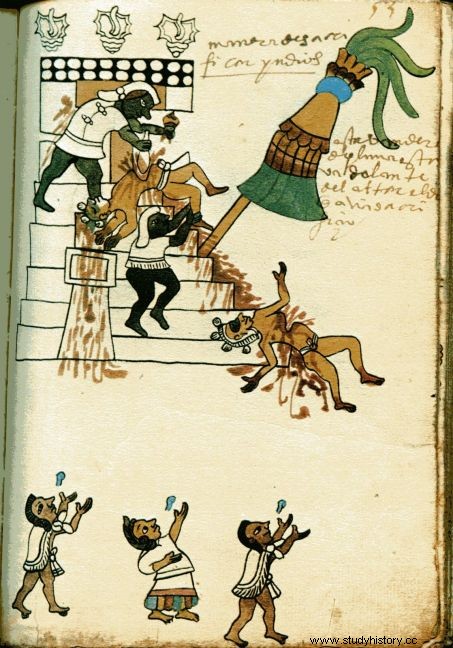Sacrificial rituals featuring the removal of the human heart were a pervasive religious practice in pre-Hispanic Mesoamerican societies. Two researchers have looked into how they could have taken place. Acts of power and intimidation as much as displays of devotion to appease the gods.

Sacrificial scene from the Codex Laud, a Mazatec manuscript now housed in the Bodleian Library, Oxford (UK). This pre-Columbian codex details the initiation of priests.
For how many sacrificed victims was the vision of the vault of heaven the last tragic image taken into the afterlife? Concerning pre-Columbian Mesoamerica, history establishes that they were tens of thousands to see the birds spinning in the sky blackened by the thick smoke of copal rising from the censers, while the priest gave them death. The macabre staging was immutable. Four chachalmecas - name of the priests dedicated to these tasks – lay the victim on the sacrificial stone, chest turned towards the sky and feet and legs firmly held. A fifth officiant would pull his head and throat down to the ground. The sacrificer then pierced the victim's rib cage with a long flint knife, before plunging his hand into the gash to remove the hot, throbbing heart (yollotl in Nahuatl) - seat of the soul - to raise it towards the sun. Then, approaching the stone or wooden idols, he smeared their mouths with the blood of the freshly extracted organ, before throwing it into a brazier to later recover the precious ashes. The remains of the victims were then thrown from the top of the stairs of the temples to descend the steep steps to the ground, thus making communion, in this trail of blood poured, the sky with the Earth.

Illustration of a sacrifice by cardiectomy from the 16th century Atlas of Diego Durán, a Dominican missionary and Spanish historian who lived in New Spain. Author of the History of the Indies of New Spain and the Islands of the Mainland, (Codex Durán), this document is devoted to the Aztecs and their history. © Codex Duran
Human sacrifices from a forensic perspective
"For more than 2,000 years, human sacrifice by cardiectomy (heart extraction)were carried out in Mesoamerica until shortly after the arrival of the Spaniards, in the 16 th century. With a notable increase in these practices around AD 700-1000" , explains Vera Tiesler, professor of bioarchaeology at the Autonomous University of Yucatan (Mexico) where she teaches funeral traditions. In an article published in the journal Current Anthropology, Co-authored with Guilhem Olivier, a specialist in Mesoamerican religions at the Institute for Historical Research of the National Autonomous University of Mexico, the two researchers expose how ceremonial human sacrifices were technically carried out. A forensic angle little discussed so far. To do this, they sifted through all the ethnohistorical literature – codices, chronicles – as well as the themes of the murals and ceramic decorations.
The researchers also analyzed the remains of several dozen victims of these sacrifices found during various archaeological excavations and were able to identify the tangible traces of the impacts left on the bones by the cutting edge of the blades of the sacrificers during the cardiectomies. "The violent penetration of an object into the chest of a victim who is still alive inevitably leaves sequels, explains Vera Tiesler, joined by Sciences et Avenir . These fractures and other marks make it possible to deduce the nature of the entry wounds and the types of instruments used" . Result:Three distinct techniques were highlighted, including two hitherto unknown. "L the first and best known was the cuts directly below the ribs, or subdiaphragmatic thoracotomy, what the Aztecs called the "ordinary sacrifice"; then there was the incision between two ribs or intercostal thoracotomy; and the horizontal separation of the sternum to access the heart, or Bilateral transverse thoracotomy". The frequency of sacrifices and the number of victims varied greatly depending on the era and the region, exceptionally massive sacrifices were also made, with hundreds of captives immolated.

Different chest openings for cardiectomies. The diaphragm line is shown as a dotted line (between c and e). © Vera Tiesler &Cucina.
Feeding the gods
The two researchers also devote part of the article to the vision that the ancient Mexicans - Mayas and Aztecs - had of the human body as a source of energy. Seat of "vital matter", the heart and the blood were thus intended to nourish the divinities. Scenes of sacrifices that had horrified the first Europeans when they arrived in the New World. "In Mesoamerican myths, humans were indebted to their creators who had sacrificed themselves to create the celestial bodies and the Earth, before sacrificing themselves to give life to men, explains Guilhem Olivier. It was therefore up to the latter to reconstitute these primordial sacrifices, and therefore to venerate their creators by nourishing them. Just as humans depended on corn for sustenance, the gods needed prayers and human bodies to be revitalized and gain strength." summarizes the specialist.

Scene of human sacrifice with bodies thrown down the steps, symbolically linking, by the trail of bloodshed, the sky with the Earth. Illustration from the Codex Tudela, a document produced in mid-16th century Mexico. © Codex Tudela
Often prepared for weeks, sometimes months among the Aztecs, the sacrificial victims intended to feed the gods were mostly war captives representing the Mimixcoa ("snakes of the clouds"), victims of the Sun in an origin myth. These men were mainly intended to feed the Sun and the Earth. "Another sacrificial category was represented by slaves. These function was to personify and nourish the myriads of other deities believed to be reborn after these ritual deaths" , add the authors of the article. Did the victims go to the sacrifice without flinching? Were they given tranquilizing drinks? Researchers still do not have definitive answers to these questions. "Some resisted, of course, and they had to be dragged by force to the sacrificial stone. In some codices, the future victims are represented with tears in their eyes" , says Guilhem Olivier. There are also mentions of wormwood powder thrown in their eyes or the ingestion of agave wine before the sacrifice of prisoners of war. Without specifying the function.
"These rites are perhaps to be linked to a myth in which the victims of the Sun were sacrificed because of their drunkenness" , adds the historian. There is also mention of a special drink, made from the blood stuck to the sacrificial knife and given to future victims to drink, but scholars do not know, again, whether or not it included other substances. As for the slaves, chosen to incarnate deities, it is possible that some accepted their sacrificial destiny because of the propaganda conveyed by certain texts describing heroic prisoners accepting death with joy. They may have considered that a happy fate awaited them in a solar afterlife after their death. But trickery could also sometimes pay off. One example is cited in a text, the case of a young Mayan woman, spared - but replaced by another - after having threatened to ask the gods for bad harvests! "These public scenes were also clear displays of power and intimidation", concludes the historian.
